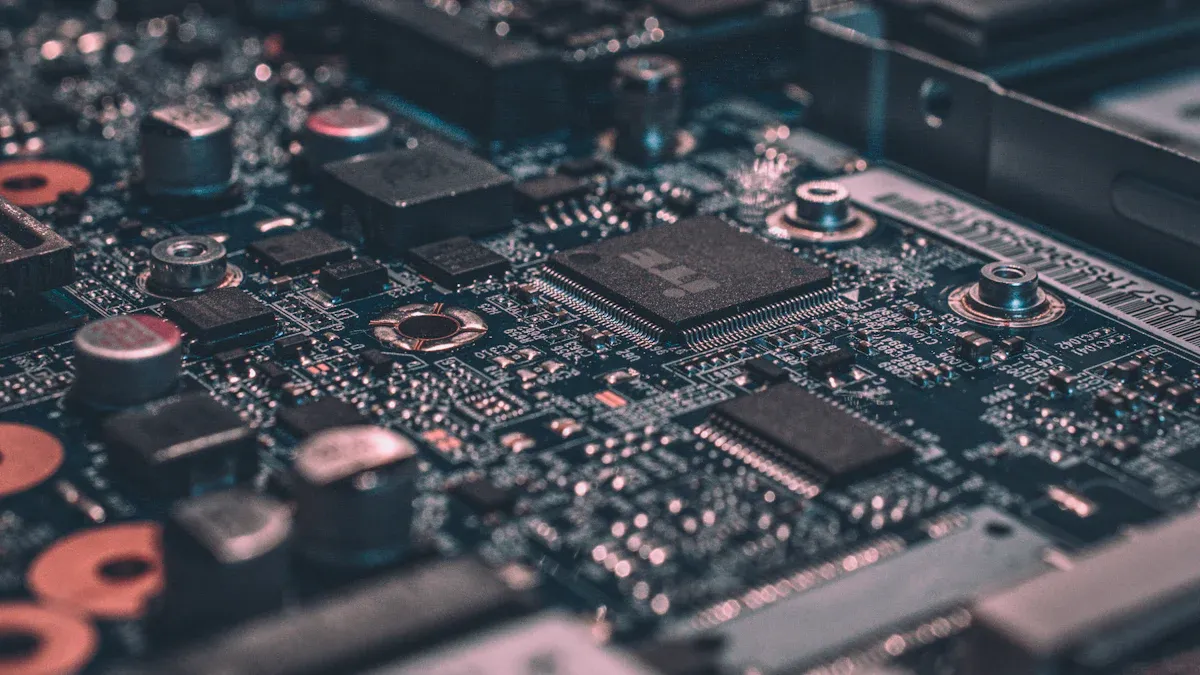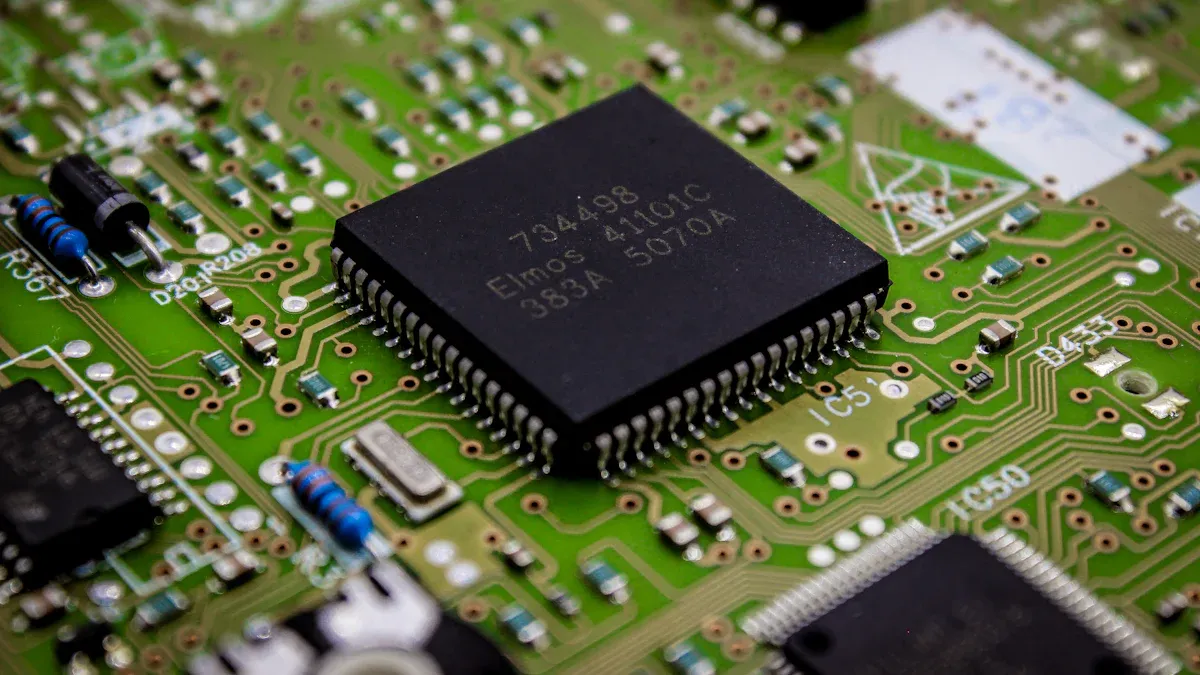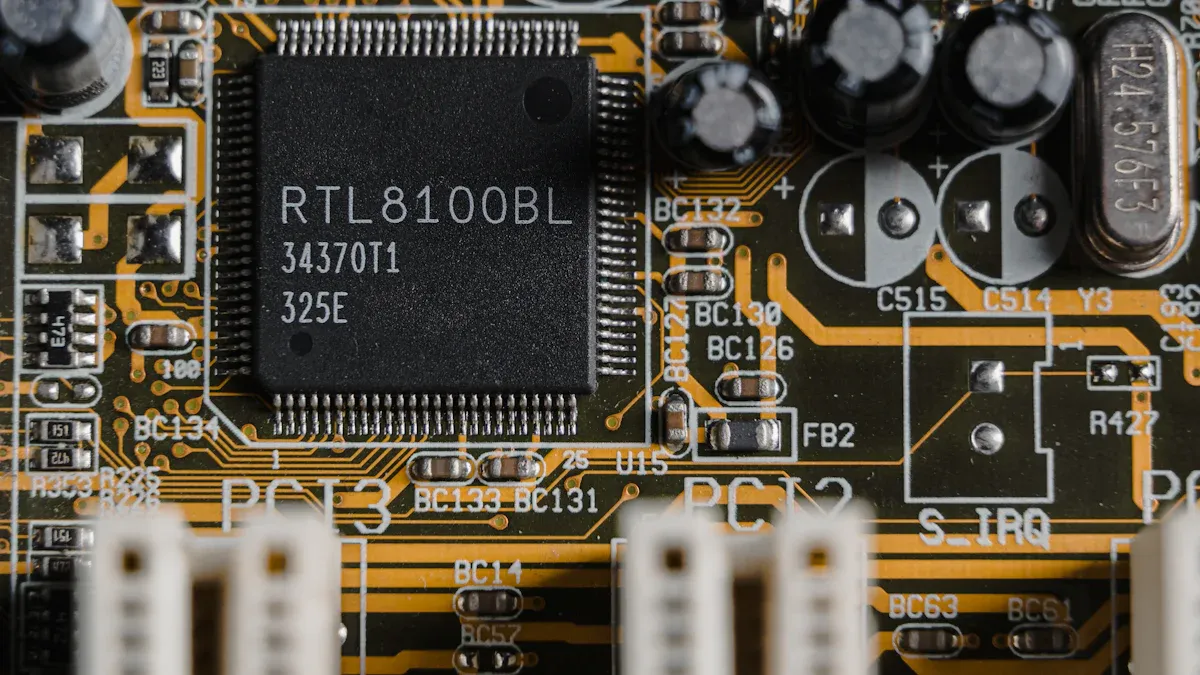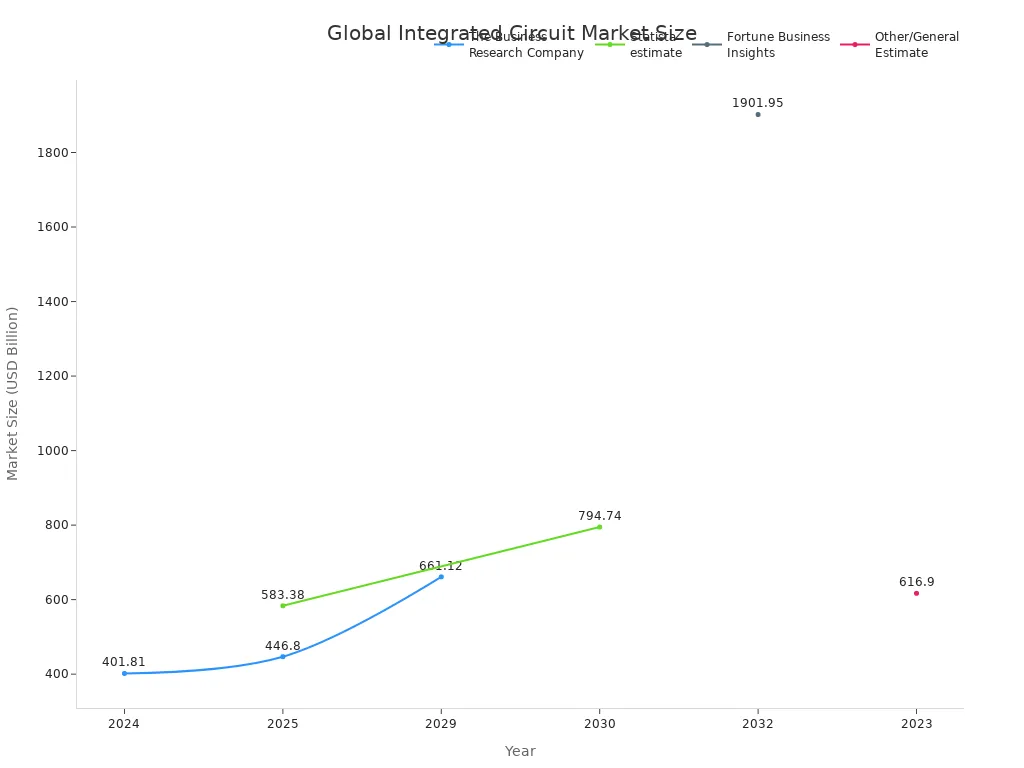What Are Integrated Circuits and How Do They Work

Integrated circuits are compact electronic devices that bring together many small components on a single chip. These chips use miniaturized parts like transistors and resistors, all built onto a silicon base. In modern chips, billions of transistors work together to control electrical signals and complete complex tasks.
Engineers increase the number of transistors by shrinking their size, stacking layers, and designing special chip structures.
Integrated circuits power smartphones, computers, and many other devices people use every day.
Key Takeaways
Integrated circuits combine many tiny electronic parts on a small chip to make devices smaller, faster, and more reliable.
Key components like transistors, resistors, capacitors, and diodes work together to control electrical signals and perform complex tasks.
Engineers build integrated circuits on silicon chips using layers and tiny metal connections to keep signals strong and devices efficient.
There are three main types of integrated circuits: analog (for real-world signals), digital (for data and logic), and mixed-signal (combining both).
Integrated circuits power everyday devices like smartphones, computers, and medical tools, offering benefits like low power use, small size, and high reliability.
Integrated Circuits Overview

Definition
Integrated circuits are small electronic devices that combine many different components on a single chip. Byjus, a leading educational platform, explains that these circuits include parts like resistors, capacitors, inductors, diodes, and transistors, all built onto a tiny semiconductor chip. These components work together to perform specific tasks. WikiChip, another trusted source, describes an integrated circuit as a semiconductor device that contains many interconnected electronic parts, usually made on a silicon chip. This design makes electronic devices smaller, faster, and more reliable.
Integrated circuits changed electronics by making circuits much smaller and more efficient. They use less power and are more dependable than older designs with separate parts.
Components
Integrated circuits contain several important components. Each part has a special job that helps the circuit work as a whole.
Component Type | Function Description |
|---|---|
Transistors | Amplify or switch electronic signals and power. |
Resistors | Control current flow and divide voltages. |
Capacitors | Store electrical energy temporarily and filter signals. |
Diodes | Allow current to flow in one direction only, acting as one-way switches. |
Microcontrollers | Combine CPU, memory, and peripherals to manage embedded system functions. |
Memory ICs | Store digital data in various forms such as RAM, ROM, EEPROM, and flash memory. |
RF ICs | Specialized for radio frequency applications in wireless communication systems. |
Power Management ICs | Manage power supply, including voltage regulation and battery management. |
Sensor ICs | Interface with sensors to measure physical parameters and convert signals for processing. |
Mixed-Signal ICs | Integrate analog and digital functions to process both signal types on one chip. |
Transistors act as switches or amplifiers. Resistors limit the flow of electricity. Capacitors store and release energy. Diodes let electricity flow in only one direction. Some integrated circuits also include microcontrollers, memory, and special parts for handling signals or power.
Structure
The structure of integrated circuits helps all the parts work together smoothly. Engineers build these circuits on a thin slice of semiconductor material, usually silicon. The silicon acts as the base, or substrate, for the whole chip. On top of the silicon, tiny wires connect the different components. At first, manufacturers used aluminum for these connections, but now copper is more common because it works better for small circuits.
Engineers start by placing transistors, resistors, capacitors, and other parts on the silicon wafer.
They connect these parts with thin metal lines, forming a network that lets electricity flow where it is needed.
The chip has layers, with each layer adding more connections or parts.
Metal pins or pads on the outside of the chip allow it to connect to other devices or circuit boards.
This layered and organized design allows integrated circuits to be very small, use little power, and work reliably in many devices.
How Integrated Circuits Work
Operation
Electrical signals move through integrated circuits by traveling along tiny metal paths that connect different components. Each part on the chip, such as transistors, resistors, capacitors, and diodes, plays a special role in shaping these signals. Transistors act as switches or amplifiers. They turn signals on or off and boost weak signals so the circuit can process information. Resistors slow down or control the flow of electricity, protecting other parts from too much current. Capacitors store and release energy, which helps filter out noise and keep signals steady. Diodes make sure current flows in only one direction, guiding signals where they need to go.
Engineers arrange these components in layers on a silicon base. This layered design allows signals to travel quickly and reliably, even in very small spaces. To keep signals clear, designers use special materials and techniques to reduce interference and timing problems.
Electrical signals are managed by:
Transistors switching and amplifying signals.
Resistors controlling current and voltage.
Capacitors storing and releasing energy for timing and filtering.
Diodes directing current flow.
Careful layout across multiple layers to keep signals strong and accurate.
Component Interaction
Transistors, resistors, and capacitors work together to perform both digital and analog tasks. Transistors switch on and off rapidly, creating the ones and zeros needed for computers and other digital devices. They also amplify signals, making them stronger for further processing. Resistors shape the flow of electricity, making sure each part gets the right amount of current. Capacitors help smooth out changes in voltage and filter unwanted noise from signals.
When these components interact, they can create timers, amplifiers, memory units, and logic gates. For example, a timer circuit uses a transistor, resistor, and capacitor to measure time intervals. An amplifier uses transistors and resistors to boost sound or radio signals. Memory units store information by controlling how charges move and stay in certain parts of the chip.
The close arrangement of these miniaturized parts allows integrated circuits to perform complex tasks quickly and efficiently. Their teamwork makes modern electronics possible.
Functions
Integrated circuits handle many important jobs in electronic devices. The table below shows some of the main tasks and examples of special chips designed for each function:
Task / Function | Description and Examples |
|---|---|
Amplification | Operational amplifier ICs (e.g., 741, LM324) |
Timing | Timer ICs such as the 555 Timer IC |
Memory Storage | Memory ICs like ROM, RAM, Flash |
Logical Operations | Logic gate ICs (74XX family: AND, OR, NOT) |
Voltage Regulation | Voltage regulator ICs (e.g., 7805, 7812) |
Integrated circuits can amplify weak signals, keep track of time, store and recall information, perform math and logic operations, and control voltage levels. Some chips combine several of these functions, making devices more powerful and compact.
Miniaturization plays a key role in how well integrated circuits work. By making components smaller and placing them closer together, engineers can fit more features into a tiny space. This reduces the distance signals must travel, which makes devices faster and more energy efficient. Smaller parts also use less power, helping batteries last longer in portable gadgets. However, packing parts tightly can create heat and interference, so designers use special layouts and cooling methods to keep everything running smoothly.
Miniaturization has allowed integrated circuits to power everything from smartphones to medical devices, making technology smaller, faster, and more reliable.
Types of Integrated Circuits
Integrated circuits come in several main types. Each type handles different kinds of signals and tasks. The three most common categories are analog, digital, and mixed-signal.
Analog
Analog integrated circuits work with continuous signals. These chips process real-world information like sound, light, or temperature. They often appear in devices that need to amplify signals or filter out noise. Common examples include operational amplifiers, voltage regulators, and audio amplifiers.
Analog ICs help radios, audio systems, and sensors work smoothly by handling signals that change over time.
Aspect | Analog Integrated Circuits |
|---|---|
Signal Type | Continuous analog signals |
Main Components | Amplifiers, comparators, filters |
Typical Applications | Audio systems, instrumentation, power management |
Amplification | |
Signal Conditioning | Filtering, impedance matching, level shifting |
Digital
Digital integrated circuits handle discrete signals, usually in the form of ones and zeros. These chips use logic gates, flip-flops, and microprocessors to process information. They form the backbone of computers, smartphones, and many other electronic devices.
Digital ICs perform tasks such as:
Storing data in memory chips (RAM, ROM, flash)
Running programs in microprocessors
Managing logic operations in calculators and controllers
Aspect | Digital Integrated Circuits |
|---|---|
Signal Type | Discrete digital signals |
Main Components | |
Typical Applications | Computers, calculators, digital signal processing |
Memory | Used for data storage |
Scalability | Highly scalable |
Digital ICs appear in smartphones, TVs, gaming consoles, and wearable devices. They help process images, store information, and control how devices work.
Mixed-Signal
Mixed-signal integrated circuits combine both analog and digital functions on a single chip. These chips can process real-world signals and digital data at the same time. They often include analog-to-digital converters (ADCs) and digital-to-analog converters (DACs).
Mixed-signal ICs are found in:
Mobile devices (for audio and sensor data)
Automotive systems (engine control, safety features)
Healthcare equipment (patient monitoring)
Industrial automation (sensor control)
Mixed-signal ICs make devices smaller, more reliable, and more efficient by reducing the need for separate chips.
Aspect | Explanation |
|---|---|
Combines sensors, amplifiers, ADCs, microcontrollers, and DSPs on one chip | |
Common Use Cases | Smartphones, smartwatches, automotive safety, healthcare, industrial sensors |
Advantages | Cost savings, miniaturization, power efficiency, improved reliability |
These three types of integrated circuits allow engineers to design a wide range of electronic products for everyday life.
Integrated Circuits in Use

Everyday Devices
Many everyday devices depend on integrated circuits to function. These chips help make electronics smaller, faster, and more reliable. People use products with these chips every day, often without realizing it.
Some common examples include:
Smartphones use chips for processing, managing input and output, and connecting to networks.
Televisions rely on chips for video processing, audio output, and smart features.
Computers depend on microprocessors and memory chips for calculations and data storage.
Household appliances, such as washing machines and microwaves, use embedded chips to control their functions.
Cars use chips in engine control units, airbag systems, and advanced driver assistance systems.
Healthcare devices, like imaging systems and wearable health monitors, use chips for accurate readings.
Smart home devices, such as thermostats and security systems, use chips for connectivity and automation.
Integrated circuits allow these devices to be compact, portable, and powerful.
Industrial and Medical
Factories and hospitals also benefit from integrated circuits. In industry, chips control robots, monitor sensors, and manage power systems. These chips help machines work safely and efficiently.
Medical equipment uses chips to process signals from sensors, display patient data, and support life-saving functions. For example, patient monitors, imaging machines, and infusion pumps all use chips to ensure accuracy and reliability.
Engineers design chips for harsh environments, so they can handle vibration, temperature changes, and electrical noise found in factories and hospitals.
Benefits and Limits
Integrated circuits offer many advantages. The table below shows the main benefits:
Benefit | Explanation |
|---|---|
Chips combine thousands of parts into one small package, making devices lighter and easier to carry. | |
Power Consumption | Chips use less energy, which helps batteries last longer and reduces environmental impact. |
Reliability | Fewer connections mean fewer chances for failure, so devices last longer and work better. |

However, these chips also have limits:
Chips are delicate and can only handle low power and voltage.
Some parts, like coils or large indicators, cannot fit inside chips.
Manufacturing uses a lot of water and energy and creates waste.
Engineers continue to improve integrated circuits, but they must solve these challenges to keep up with new technology.
Integrated circuits combine many electronic parts on a small chip to perform complex tasks like data processing and memory storage. These chips have made devices smaller, faster, and more reliable. People rely on them every day in phones, computers, and medical tools. Their design supports new technology and shapes how society works and communicates. Recognizing their role helps everyone understand why modern life depends on these tiny but powerful inventions.
FAQ
What is the main purpose of an integrated circuit?
An integrated circuit combines many electronic parts on a single chip. It helps devices work faster, use less power, and take up less space. Engineers use these chips in almost every modern electronic device.
How do engineers make integrated circuits so small?
Engineers use special machines to place tiny parts on a silicon wafer. They shrink the size of each part using advanced technology. This process allows billions of components to fit on one chip.
Can integrated circuits be repaired if they break?
Most integrated circuits cannot be repaired. If a chip fails, people usually replace the whole chip or device. The small size and complex design make repairs very difficult.
Why do some devices need both analog and digital integrated circuits?
Some devices handle real-world signals, like sound or temperature, and also process digital data. Mixed-signal integrated circuits allow these devices to work with both types of signals on one chip.
See Also
How Fully Integrated Processors Function In Modern Technology
Exploring The Importance Of Integrated Circuits In Electronics
How Integrated Battery Monitor ICs Operate And Their Uses
The Function And Purpose Of Computer Chips Explained Clearly
